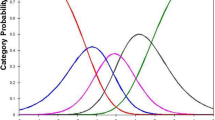Abstract
Normal male volunteers took single acute doses of either diazepam or placebo under double-blind conditions in three simulated public speaking experiments. Measures of palmar sweating and subjective anxiety showed that anticipation of speaking in public increased anxiety relative to baseline and prestress conditions, and performance of public speaking further increased anxiety. A dose-related anxiolytic effect of diazepam on subjective anxiety supported the model's clinical relevance. Moreover, the intensity of the subject's public speaking phobia predicted both degree of prestress anxiety relief from 10 mg diazepam and overall anxiety level, regardless of medication, throughout the experimental session. A measure of traditionalism predicted placebo and 5 mg diazepam response during prestress: As in previous clinical trials, high traditionalism scorers reported more relief from placebo, whereas low scorers showed more relief from diazepam.
Similar content being viewed by others
References
Bass B (1956) Development and evaluation of a scale for measuring social acquiescence. J Abnorm Soc Psychol 53:296–299
Droppleman LF, McNair DM (1969) Sensitivity of four finger sweat print durations to an anticholinergic agent. Psychophysiology 5:660–664
Droppleman LF, McNair DM (1971) An experimental analog of public speaking. J Consult Clin Psychol 36:91–96
Fisher S, Fisher RL (1963) Placebo response and acquiescence. Psychopharmacologia 4:298–301
Geer J (1965) The development of a scale to measure fear. Behav Res Ther 3:45–53
Lipper S, McNair DM (1972) Simulated public speaking and anxiety. J Exp Res Pers 6:237–240
Malmo RB (1965) Finger sweat prints in the differentiation of low and high incentive. Psychophysiology 1:231–240
McNair DM, Kahn RJ, Droppleman LF, Fisher S (1967) Compatibility, acquiescence, and drug effects. Neuropsychopharmacology 5:536–542
McNair DM, Kahn RJ, Droppleman LF, Fisher S (1968) Patient acquiescence and drug effects. In: Rickels K (ed) Non-specific factors in drug therapy. Charles C. Thomas, Springfield, pp 59–72
McNair DM, Fisher S, Kahn RJ, Droppleman LF (1970a) Drug-personality interaction in intensive outpatient treatment. Arch Gen Psychiatry 22:128–135
McNair DM, Fisher S, Sussman C, Droppleman LF, Kahn RJ (1970b) Persistence of a drug-personality interaction in psychiatric outpatients. J Psychiatr Res 7:299–305
McNair DM, Lorr M, Droppleman LF (1971) Manual: Profile of mood states (POMS). San Diego, Educational and Industrial Testing Service
McNair DM (1973) Antianxiety drugs and human performance. Arch Gen Psychiatry 29:611–617
McNair DM, Gardos G, Haskell DS, Fisher S (1979) Placebo response, placebo effect, and two attributes. Psychopharmacology 63:245–250
McNair DM, Barrett JE (1979) Two Bass Scale factors and response to placebo and anxiolytic drugs. Psychopharmacology 65:165–170
Paul GL (1962) Insight vs. desensitization in psychotherapy: An experiment in anxiety reduction. McGraw Hill, New York
Pillard RC, Fisher S (1970) Aspects of anxiety in dental clinic patients. J Am Dent Assoc 6:1331–1334
Pillard RC, McNair DM, Fisher S (1974) Does marijuana enhance experimentally induced anxiety? Psychopharmacologia 40:205–210
Weinberg A (1978) Personality and response to antianxiety agents and placebo in a laboratory model of anxiety. Doctoral dissertation, Boston University, Boston, MA, USA
Author information
Authors and Affiliations
Rights and permissions
About this article
Cite this article
McNair, D.M., Frankenthaler, L.M., Czerlinsky, T. et al. Simulated public speaking as a model of clinical anxiety. Psychopharmacology 77, 7–10 (1982). https://doi.org/10.1007/BF00436092
Received:
Accepted:
Issue Date:
DOI: https://doi.org/10.1007/BF00436092




